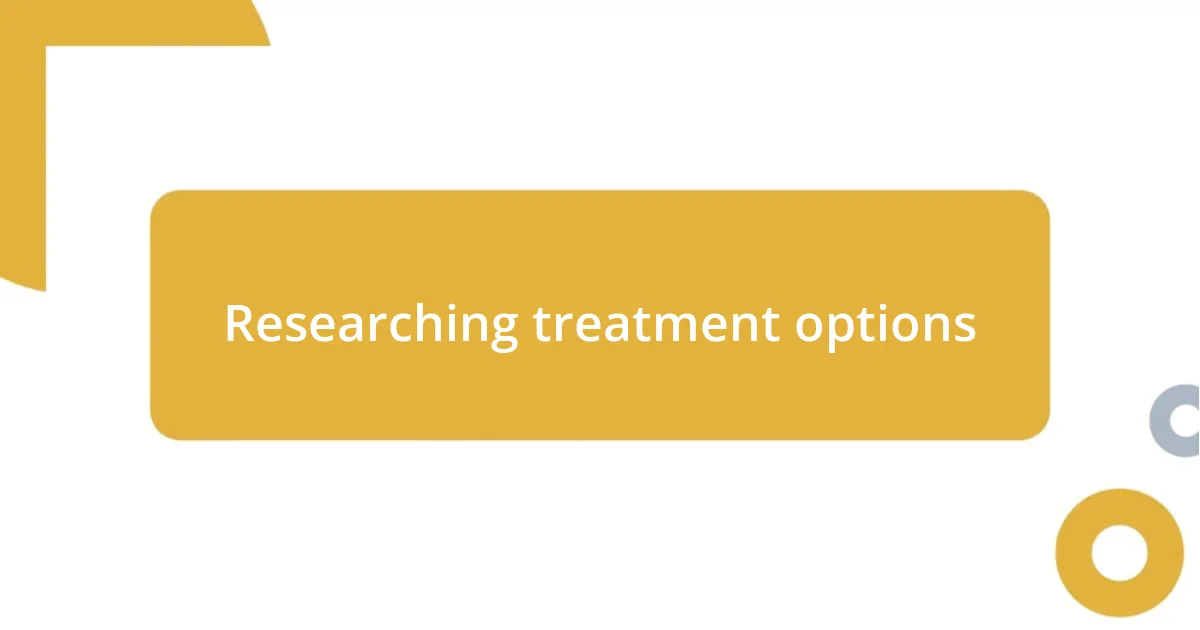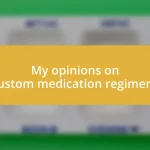Key takeaways:
- Targeted therapies personalize cancer treatment by focusing on specific genetic mutations, empowering patients to take charge of their health journey.
- Engaging with healthcare professionals and utilizing resources such as genetic testing and community support enhance understanding and foster proactive participation in treatment decisions.
- Documenting treatment progress through symptoms and reflections helps patients communicate effectively with their healthcare team and celebrate milestones along the way.

Understanding targeted therapies
Targeted therapies are fascinating because they focus on specific characteristics of a disease, particularly in cancer treatment. When I first encountered the concept, I was struck by how these therapies aim to attack only the cancer cells while sparing healthy ones. It felt like a targeted missile rather than a bomb that could destroy everything in its path. Have you ever wondered how something so precise is possible in medicine?
I remember sitting in my doctor’s office, feeling overwhelmed by the options available. When she explained targeted therapies, it struck me how personalized treatment could be. I felt a glimmer of hope, knowing that my treatment could be tailored to my specific situation rather than following a one-size-fits-all protocol. It made me realize that understanding the genetic makeup of my cancer could unlock a path toward more effective care.
As I delved deeper into this topic, I discovered the importance of biomarkers. These indicators help identify which therapies might work best for me by profiling the genetic mutations of my cancer. It felt empowering to know that there was a way to get answers that were unique to my health journey. Have you explored how biomarkers could play a role in your own health decisions? Learning about them opened my eyes to the evolving landscape of targeted treatments and gave me a sense of ownership over my health.

Assessing my medical condition
To assess my medical condition, I started with thorough research and consultations. I vividly remember the day when I gathered my medical history and the reports from my tests. As I laid out the details, I found myself trying to connect the dots, almost like piecing together a puzzle. This process helped me not only understand my condition better but also sparked insightful discussions with my healthcare team. It’s interesting how proactive involvement can lead to a clearer picture of what you’re facing.
Taking a deeper dive into my diagnosis, I embraced the reality of understanding my unique biological markers. I recall the moment when I received my genetic testing results—it felt like unlocking a door to deeper insights about my health. This was not just about having a condition; it was about understanding how my body responds to specific treatments. I began to see my illness through a new lens, feeling that I was no longer just a passive recipient of care but an active participant in my treatment journey.
I also explored various tools and resources that provided insights into my medical status. Utilizing online platforms and support groups created a sense of community, which was incredibly comforting. Sharing experiences with others who faced similar challenges reassured me that my questions were valid. Have you ever felt supported by a community when navigating your health journey? For me, it truly emphasized that every individual’s condition is unique and deserved personalized attention.
| Assessment Method | Description |
|---|---|
| Research | Gathering information about my condition and available therapies. |
| Genetic Testing | Understanding the specific biological markers that inform treatment options. |
| Community Support | Engaging with others to share experiences and insights about navigating health challenges. |

Researching treatment options
Researching treatment options involved a lot of curiosity and digging into various sources. I remember sifting through articles and reputable medical websites as if I were on a treasure hunt, seeking gems of knowledge. Each piece of information felt like a direct conversation with experts, helping to demystify the complexities of targeted therapies. It was both enlightening and reassuring to come across firsthand accounts from other patients who shared their experiences, which fueled my resolve to learn even more.
While exploring my treatment possibilities, I found it essential to consider several key resources:
- Medical Journals: I discovered clinical studies that examined the efficacy of targeted therapies.
- Online Forums: Interacting with fellow patients offered real-life insights into their journeys and outcomes.
- Podcasts/Webinars: Listening to expert discussions allowed me to grasp intricate concepts easily.
- Patient Advocacy Groups: These organizations provided vital support and direction for navigating my treatment options.
- Consulting with Specialists: Scheduling appointments with different oncologists helped me gather diverse opinions and personalized advice.
Each resource shaped my understanding and gave me the confidence I needed to make informed choices about my health. The emotional lift from these discoveries was profound; I felt less like a passive participant and more like a proactive collaborator in my treatment journey.

Evaluating potential side effects
When evaluating potential side effects, I often found myself weighing the immediate benefits of treatment against the risks that might follow. For instance, during one of my consultations, a doctor candidly discussed a possible side effect that could significantly alter my day-to-day life. That conversation struck me deeply; I realized it wasn’t just about treating my condition, but about maintaining my overall quality of life.
As I gathered more information, I made it a point to jot down specific side effects I encountered in my research. One evening, while reading up on a particular drug, I came across testimonials that mentioned fatigue and nausea. Both buzzwords hit home for me—I’ve always cherished my active lifestyle. I remember thinking, “How would I cope with those symptoms if they really developed?” That introspection guided my decisions and emphasized the need for flexibility in my treatment plan.
While attending a support group meeting, I was intrigued by others’ reactions to various therapies. I heard someone share how they’d had to pause their treatment due to unbearable side effects. It was a stark reminder that each journey is distinct. I often reflect on that moment: What if I were faced with a similar scenario? It underscored the importance of ongoing evaluations, allowing me to be prepared to adapt as necessary.

Consulting with healthcare professionals
When it came to consulting with healthcare professionals, I found that building a personal rapport with each specialist was key. The first time I met with an oncologist, I was nervous but made it a point to share my research findings and thoughts. I remember the way her eyes lit up when I asked about integrating specific targeted therapies into my treatment plan. That moment reminded me how important it is to view healthcare conversations as a partnership, where both patient and provider can contribute their knowledge.
During one memorable consultation, I vividly recall how a nurse practitioner took the time to explain complex jargon in simple terms. When she walked me through how targeted therapies work at a cellular level, every word seemed to resonate with my earlier research. Her patience made me feel validated and empowered, sparking a deeper understanding of my choices. I couldn’t help but wonder: How many others might hesitate to ask questions for fear of seeming uninformed? That experience motivated me to embrace curiosity in every appointment, knowing it leads to clarity.
Ultimately, trust and communication with healthcare professionals significantly influenced my treatment journey. I learned that asking the right questions can lead to more personalized advice. For instance, when I expressed my concerns about side effects during a follow-up, my doctor provided insights on how to manage them proactively. Have you ever thought about what makes for the most effective dialogue with your healthcare team? For me, it was opening up about my feelings and concerns, fostering a more collaborative path to my targeted therapy decisions.

Making an informed decision
Making an informed decision is really a journey of self-discovery. I remember sitting in my living room one afternoon, surrounded by medical journals and my trusty laptop, sipping on herbal tea. As I dug through the information, I felt a mix of excitement and anxiety—was I really ready to take charge of my health? This moment crystallized for me the importance of looking beyond clinical data and truly understanding what those numbers meant for my life.
I’ve found that engaging in discussions with others who’ve faced similar decisions can be enlightening. One evening, I joined an online forum where someone shared their meticulous process of weighing the pros and cons of targeted therapies. Their enthusiasm for breaking down information into bite-sized pieces inspired me. It made me reflect on how crucial it is to surround ourselves with supportive voices, don’t you think? Those conversations often reinforce our confidence and help clarify what matters most to us.
As I synthesized all I learned, the power of personal values became clear. I realized that my decision wasn’t just about following the latest medical trends; it was about how these choices aligned with my lifestyle and aspirations. For example, my desire to maintain my energy throughout the day weighed heavily on my choice of therapies. I’ve often asked myself: “What does quality of life look like to me?” Answering that question became a North Star, guiding me in my deliberations as I navigated treatment options.

Monitoring my treatment progress
Monitoring my treatment progress was a vital aspect of my journey. I remember setting up a dedicated journal where I could jot down daily symptoms, side effects, and emotional reflections. This practice not only allowed me to track my physical response but also served as an outlet for the rollercoaster of emotions I experienced. How often do we overlook the importance of documenting our feelings in relation to our health? For me, writing it down was as critical as any medical report.
Every follow-up appointment turned into a mini pep rally for me. Armed with my notes, I was ready to share my observations and discuss whether my targeted therapies were hitting the mark. During one visit, my oncologist noticed the progress I’d documented and commented on how valuable it was for tailoring my treatment. That feeling of being an active participant was empowering. It made me realize that monitoring wasn’t just about the numbers; it was about sharing my personal health narrative.
I often found myself reflecting on the little wins along the way. When I noticed a decrease in side effects, it felt like a major victory worth celebrating. But on tougher days, I reminded myself that challenges are part of the process. Have you ever thought about how acknowledging both the high and low points can shape your perspective on treatment? For me, those contrasts painted a comprehensive picture of my health journey, reinforcing my commitment to ongoing monitoring and adjustment as needed.














